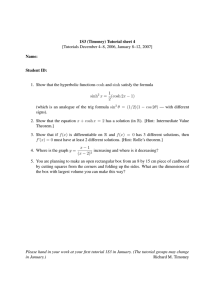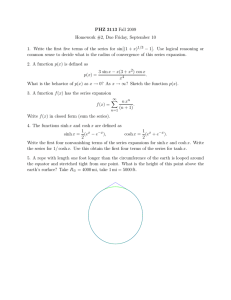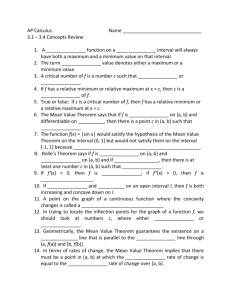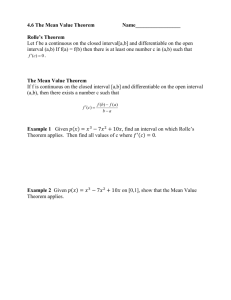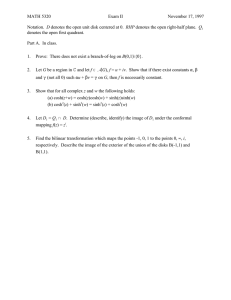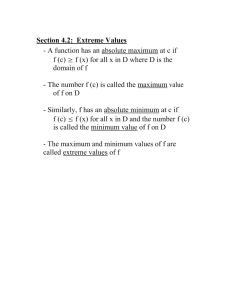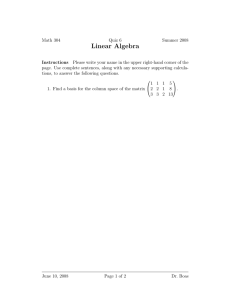1S3 (Timoney) Tutorial sheet 4
advertisement
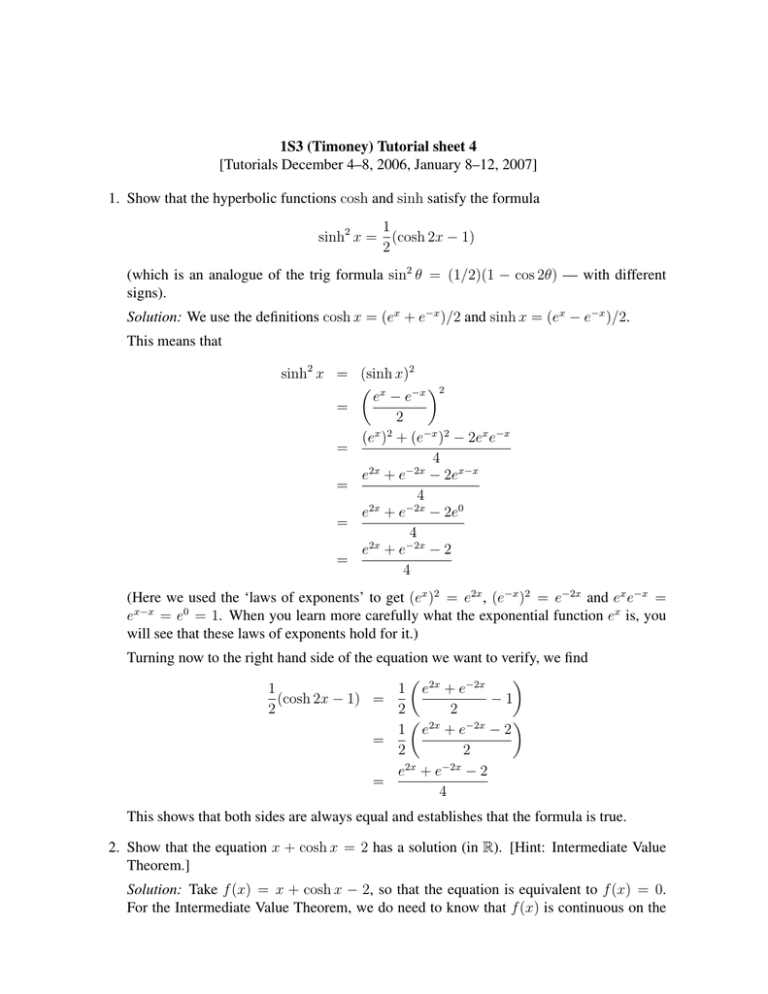
1S3 (Timoney) Tutorial sheet 4 [Tutorials December 4–8, 2006, January 8–12, 2007] 1. Show that the hyperbolic functions cosh and sinh satisfy the formula 1 sinh2 x = (cosh 2x − 1) 2 (which is an analogue of the trig formula sin2 θ = (1/2)(1 − cos 2θ) — with different signs). Solution: We use the definitions cosh x = (ex + e−x )/2 and sinh x = (ex − e−x )/2. This means that sinh2 x = (sinh x)2 x 2 e − e−x = 2 x 2 (e ) + (e−x )2 − 2ex e−x = 4 e2x + e−2x − 2ex−x = 4 2x −2x e +e − 2e0 = 4 e2x + e−2x − 2 = 4 (Here we used the ‘laws of exponents’ to get (ex )2 = e2x , (e−x )2 = e−2x and ex e−x = ex−x = e0 = 1. When you learn more carefully what the exponential function ex is, you will see that these laws of exponents hold for it.) Turning now to the right hand side of the equation we want to verify, we find 1 1 e2x + e−2x (cosh 2x − 1) = −1 2 2 2 1 e2x + e−2x − 2 = 2 2 2x −2x e +e −2 = 4 This shows that both sides are always equal and establishes that the formula is true. 2. Show that the equation x + cosh x = 2 has a solution (in R). [Hint: Intermediate Value Theorem.] Solution: Take f (x) = x + cosh x − 2, so that the equation is equivalent to f (x) = 0. For the Intermediate Value Theorem, we do need to know that f (x) is continuous on the interval we use in the theorem. But, in fact f (x) is differentiable and so continuous on the whole of R. (Perhaps you have not really learned that yet.) Now we need an interval where f (x) changes sign. f (0) = 0 + cosh 0 − 2 = 0 + (e0 + e0 )/2 − 2 = (1 + 1)/2 − 2 = −1 < 0 and f (2) = 2 + cosh 2 − 2 = cosh 2 > 0. Thus we can apply the Intermediate Value Theorem on the interval [a, b] = [0, 2] to conclude that there is some c ∈ (0, 2) with f (c) = 0. 3. Show that if f (x) is differentiable on R and f (x) = 0 has 3 different solutions, then f 0 (x) = 0 must have at least 2 different solutions. [Hint: Rolle’s theorem.] Solution: Say the 3 solutions of f (x) = 0 are a1 , a2 and a3 and suppose we number them in increasing order, that is so that a1 < a2 < a3 . To see what is going on, it should help to make a little graph of y = f (x) with the 3 points where the graph crosses (or touches) the x-axis at x = a1 , x = a2 and x = a3 . Since f (a1 ) = f (a2 ) = 0, we can apply Rolle’s theorem on the interval [a1 , a2 ] to conclude there is c1 ∈ (a1 , a2 ) with f (c1 ) = 0. (To be sure this is justified we have to check that the hypotheses of the theorem are satisfied. But since f (x) is differentiable on R, it must also be continuous on R. So we can be sure that f is continuous on the closed interval [a1 , a2 ] and differentiable on the open interval (a1 , a2 ).) Since f (a2 ) = f (a3 ) = 0 we can also apply Rolle’s theorem on the interval [a2 , a3 ] to conclude there is c2 ∈ (a2 , a3 ) with f (c2 ) = 0. As c1 < a2 and a2 < c2 , we have c1 6= c2 and two solutions of f (x) = 0. 4. Where is the graph y = x−1 increasing and where is it decreasing? (x − 2)2 Solution: The idea is to find the intervals where the derivative is negative. dy dx is positive and where it dy 1(x − 2)2 − (x − 1)(2)(x − 2) = dx (x − 2)4 (via the quotient rule) (x − 2) − 2(x − 1) = (x − 2)3 −x = (x − 2)3 x<0 0<x<2 2<x x − + + x−2 − − + (x − 2)3 − − + −1 − − − dy x − + − = − (x−2)3 dx y decreasing increasing decreasing 2 From this we see that the graph is increasing for 0 ≤ x < 2 (or on the interval [0, 2)). (We cannot include x = 2 because the function is not defined there.) It is decreasing for x ≤ 0 (or on the interval (−∞, 0]) and for x > 2 (interval (2, ∞)). 5. You are planning to make an open rectangular box from an 8 by 15 cm piece of cardboard by cutting squares from the corners and folding up the sides. What are the dimensions of the box with largest volume you can make this way? Solution: Here is a diagram of the situation. We have taken x as the length of side of the square to be cut out at each corner. The volume of the box is V = (8 − 2x)(15 − 2x)x and the problem is to find the largest value of V that is possible. Clearly x ≥ 0 is essential and also x ≤ 4. The end points x = 0 and x = 4 give V = 0 and so the maximum most be at a critical point x in the range dV dV 0 < x < 4. We find = 4(3x2 − 23x + 30) and the solutions of = 0 are dx dx √ √ 23 ± 232 − 360 23 ± 169 23 ± 13 x= = = 6 6 6 or x = 5/3 and x = 6. Thus the maximum volume happens at x = 5/3 and the dimensions required are 14/3, 35/3 and 5/3 cm. 3

